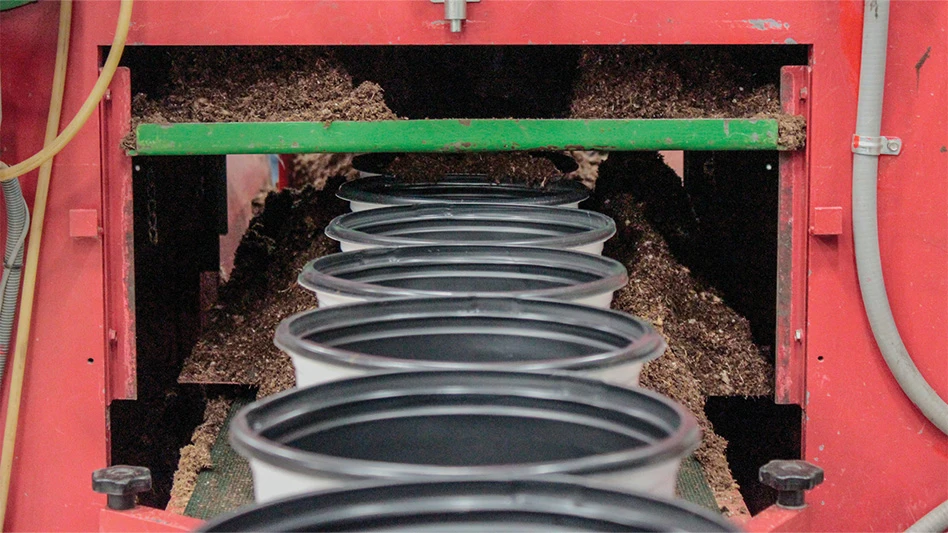
Does your substrate pH have you on a rollercoaster with unwanted ups or downs? This article is for the greenhouse or nursery manager responsible for substrate mixing. Below is a simple procedure for more accurately predicting the necessary lime rate to reach a target pH for any substrate. The A+ method is a modification of a procedure developed by James Altland, refined by Erin Lowe, biotechnician extraordinaire, and further modified by Drs. Altland and James Owen Jr. at the USDA Agricultural Research Service Application Technology Research Unit Laboratory in Wooster, Ohio.
This procedure works with any combination of substrate components and amendments. It starts by accurately preparing 8 liters of your amended substrate. That 8-liter batch is moistened before being divided into 1-liter batches and amended with a range of lime rates. Finally, pH is measured, allowing you to accurately predict any lime rate to reach a target pH. Below is the step-by-step process to optimizing your pH using the “A+ method."
Making and measuring unamended substrate using your components (2 options)
Option 1: Premade substrate: Loosely fill a 4-liter pitcher (Photo 1) to the 4-liter (or 4000 mL) mark using unamended substrate comprised of your components (i.e. peat, bark, coir) in its correct proportions. Lightly tap or drop the container to set bulk density before filling again to the 4-liter mark. Repeat filling the 4-liter pitcher so that you have a substrate pile containing a total of 8 liters of substrate.
Option 2: Making your own substrate: Construct a pile of your substrate in the correct component proportions (i.e. peat, bark, coir). For example, a 30% (by volume) peat amended bark substrate would be three scoops of loose, moist peat and seven scoops of moist bark. Then mix the substrate until it visually appears and feels the same as your typical substrate before measuring the 8 liters of substrate as described above.

Amend your substrate with pre-plant fertilizer amendments (e.g. micronutrient packages, water soluble nutrients, etc.)
1. Dump your container on the potting table or concrete.
2. Spread out substrate into an approximately 6-foot by 4-foot square.
3. Using any digital scale, weigh out 4.7 grams of your amendment for each pound you would add to a cubic yard (27 cubic feet). For example, if you normally add 1.5 pounds per cubic yard of granulated micronutrients, you will add 7.1 grams of micronutrients to 8 liters of substrate (1.5 x 4.7 = 7.1 grams).
4. Apply the pre-measured amount of each amendment (e.g. mineral nutrients, aluminum sulfate), except lime or dolomite, by “salt and peppering” the surface of your 6-foot by 4-foot square of substrate.
5. Incorporate your amendments by table mixing; this is accomplished by moving the pile three times from one location to another in small scoops, pouring atop the pile to let it homogenize.
6. Add irrigation water to substrate and continue mixing until moist, but no free water is visible. The substrate will feel relatively moist in your hand but not make your hand wet when handling.
Adding multiple rates of lime or dolomite
7. From your 8-liter pile of amended substrate, create sub-batches by accurately dividing the larger pile into 8 seperate 1-liter piles.
8. Gather eight 1-gallon Ziploc bags. Using a permanent, water-resistant marker, label one bag "0 pound per cubic yard." Fill the bag with 1 liter of substrate and set aside. After testing, this will reveal the baseline pH of your substrate blend without added lime.
9. Label an additional four (or up to seven) 1-gallon Ziploc bags with a permanent, water-resistant marker to indicate the lime rate. This rate can be anywhere from 1 pound per cubic yard and up. Place each bag beside its own sub-batch pile.
10. Using the data in Table 1, add lime or dolomite for each individual rate to a corresponding substrate sub-batch pile. For example, adding 1.2 grams of dolomite to a 1-liter sub-batch will give you an effective rate of 2 pounds per cubic yard.
11. Mix in the lime or dolomite into the 1-liter sub-batch pile for 30 seconds to a minute or until thoroughly blended.
12. Further moisten the lime or dolomite amended sub-batch pile with irrigation water as needed to ensure you have consistently moist (not wet) amended substrate mix.
13. Place each mixed 1-liter sub-batch pile of substrate into its own appropriately labeled 1-gallon Ziploc bag.
14. Let sit for 72 to 96 hours.
Measuring pH
15. Add 1 liter of your irrigation water to each prepared Ziploc bag.
16. Let sit for a minimum of 60 minutes and no more than two hours.
17. Calibrate your pH probe while waiting.
18. Stick your pH probe into the Ziploc bag holding your prepared slurry of one part substrate and one part water.
19. Record pH from each Ziploc bag, noting rate of lime or dolomite added.
20. Rinse pH probe before moving to next Ziploc bag. (Repeat steps 18 to 20.

Identifying your lime or dolomite rate to achieve your desired pH
- 21. Enter data into Microsoft Excel (or Google Sheets) using two columns: one column for the substrate lime rate and one column for the corresponding measured pH.
- 22. Plot data in Excel by first clicking on “Insert” at the top left, highlighting data and choosing the charts icon with only dots. Then, right click and add trendline. Choose a linear or polynomial trendline from format trendline on the right side of your screen. Data will typically “best fit” with polynomial. If wanted, you can also add the equation from the trendline.
- 23. Find the optimal pH on the y-axis (left vertical axis) and follow parallel to the x-axis (horizontal bottom axis) to where it intersects your curve on the graph. Then move straight down to the x-axis to determine the optimal lime rate. An example is provided in spreadsheet image (Fig. 1), with intersecting dashed lines indicating an optimal pH of 5.8 using 3.9 pounds of lime per cubic yard.
Utilizing the data
Now you have a standard operating procedure. Keep records of the substrate composition, amendment labels and rates, as well as the label for lime or dolomite used. Repeat the A+ method to identify optimal liming rate when any changes occur to your substrate composition, source, texture, age or chemistry of amendments, including lime or dolomite. Track changes of pH curves and corresponding in-field monitoring (e.g. pour-through method) over time. The combination of these factors will allow you to track the consistency of your substrate pH throughout the season.

Explore the May 2024 Issue
Check out more from this issue and find your next story to read.
Latest from Greenhouse Management
- The HC Companies, Classic Home & Garden merge as Growscape
- Eason Horticultural Resources will now officially be known as EHR
- BioWorks receives EPA approval for new biological insecticide for thrips, aphids, whiteflies
- ScottsMiracle-Gro transfers cannabis subsidiary to focus on core lawn and garden business
- Ellen Mackenbach-Lakeman appointed new CEO of Dümmen Orange
- Southern Garden Tour sets 2025 dates for trial garden open houses
- Belgian thermal screen manufacturer Phormium launches Noctis Thermo
- New book explores plants that thrive in Rocky Mountains





